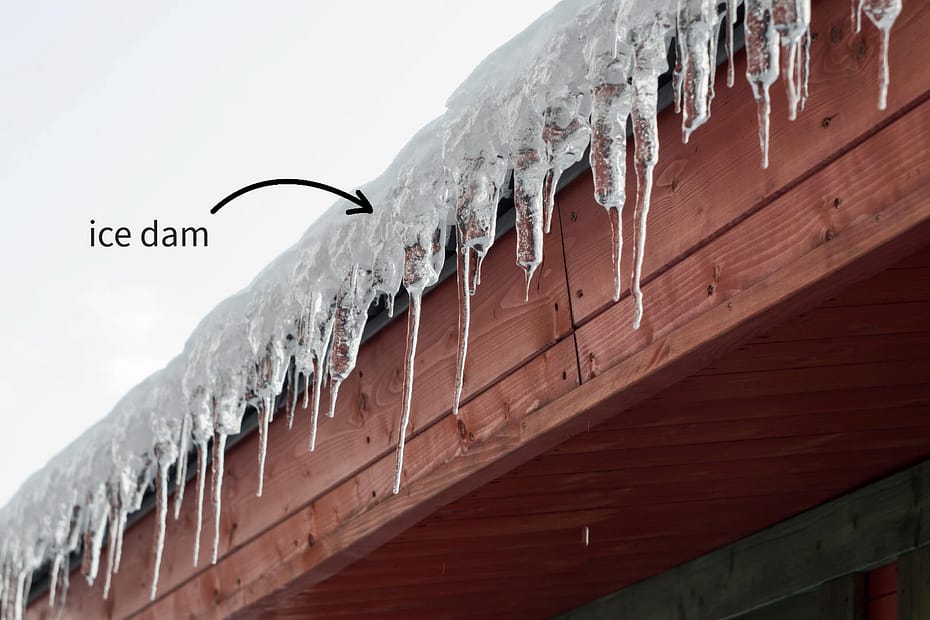To prevent ice dams on roofs, ensure even roof temperatures by improving attic insulation and ventilation. Regularly clear snow with roof rakes and keep gutters clean. In severe cases, consider professional solutions like heated roof cables or consulting roofing specialists.
Table of contents
What is an Ice Dam?
An ice dam is a ridge of ice that forms at the edge of a roof, preventing the melted snow (water) from properly draining off the roof. Instead of flowing into the gutters and downspouts, the water gets trapped behind this ice barrier, pooling on the roof. This pooled water can then seep under shingles, potentially causing leaks and water damage to the roof, attic, and the interior of the home.
The appearance of an ice dam can be deceiving; from the ground, it might merely look like a thick edge of ice along the eaves of your house. However, the real issue is not the visible ice itself but the water accumulation it’s trapping behind it.
The Science Behind Ice Dams
Ice dams form primarily due to uneven roof temperatures. When snow accumulates on a roof, the heat from inside the home often warms the upper sections of the roof, causing the snow to melt. This meltwater then flows down towards the colder eaves. Upon reaching these cooler sections, the water refreezes, creating an ice barrier.
Over time, with repeated cycles of melting and refreezing, this ice barrier grows into a more substantial ice dam. As the dam builds, it prevents subsequent meltwater from draining off the roof, leading to water pooling behind it. Fluctuating temperatures and recurring snowfalls can further exacerbate this process.
How Do Ice Dams Affect Roofs?
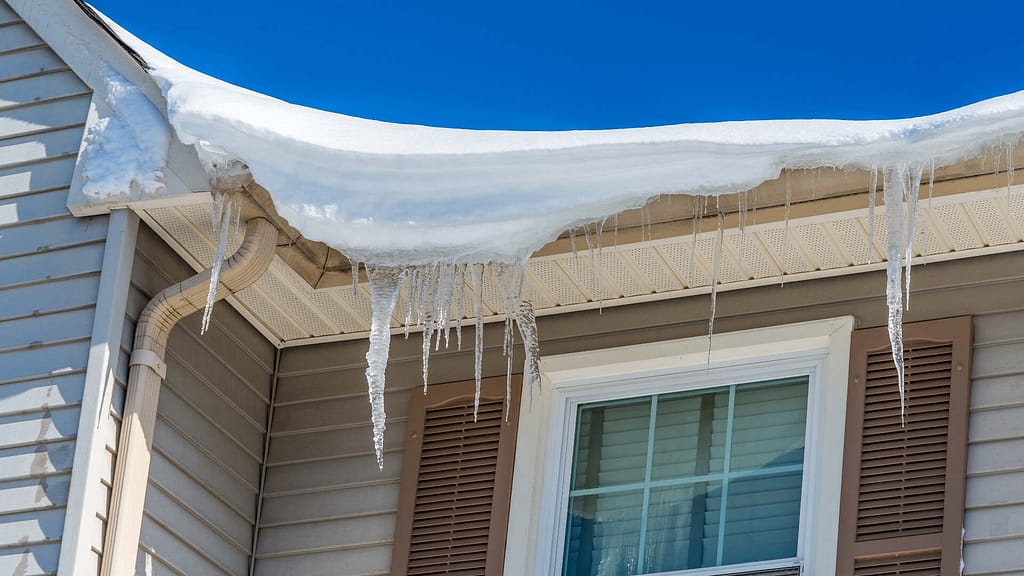
Ice dams, with their picturesque icicle formations, can deceive with their beauty, hiding the real risks they pose to roofs and homes. Here’s how they impact structures:
- Water Intrusion: Ice dams trap melted snow behind them, and as they grow, they can cause water to find its way beneath roofing shingles, potentially leading to roof leaks. This infiltration can result in dampness and potential mold growth inside the attic or living spaces.
- Structural Weakening: Persistent moisture from trapped water can erode the roof’s structural integrity. Over time, this can result in rotting wood and compromised insulation, increasing the vulnerability of the roof and decreasing its lifespan. This damage can significantly increase your roof replacement cost in the future.
- Strain on Roof Structure: Large ice dams bring added weight to a roof. This strain can pose risks to gutters, shingles, and the roof deck itself, potentially leading to structural issues or even collapses in extreme cases.
- Shingle Damage: The freezing and thawing cycles associated with ice dams can lift and damage roofing shingles. This not only exposes the roof to the elements but also makes it more susceptible to future leaks.
- Gutter and Foundation Risks: As ice dams melt, especially during rapid thaw periods, the water can overflow gutters. This excessive water flow can damage the home’s foundation and landscape, leading to further structural concerns and potential basement flooding.
- Aesthetic Damage: Beyond structural concerns, ice dams can also damage the aesthetic appeal of a home. Stained ceilings, peeling paint, and damaged siding can all result from water intrusion and ice accumulation.
While ice dams may seem like harmless ice formations, they carry with them a host of potential problems that can have lasting repercussions for the health and longevity of a roof and home.
Ways to Prevent Ice Dam Formation
Ice dams can cause significant damage to your roof and home, but with a few preventive measures, homeowners can mitigate the risk. Here’s how:
Cleaning Gutters and Downspouts
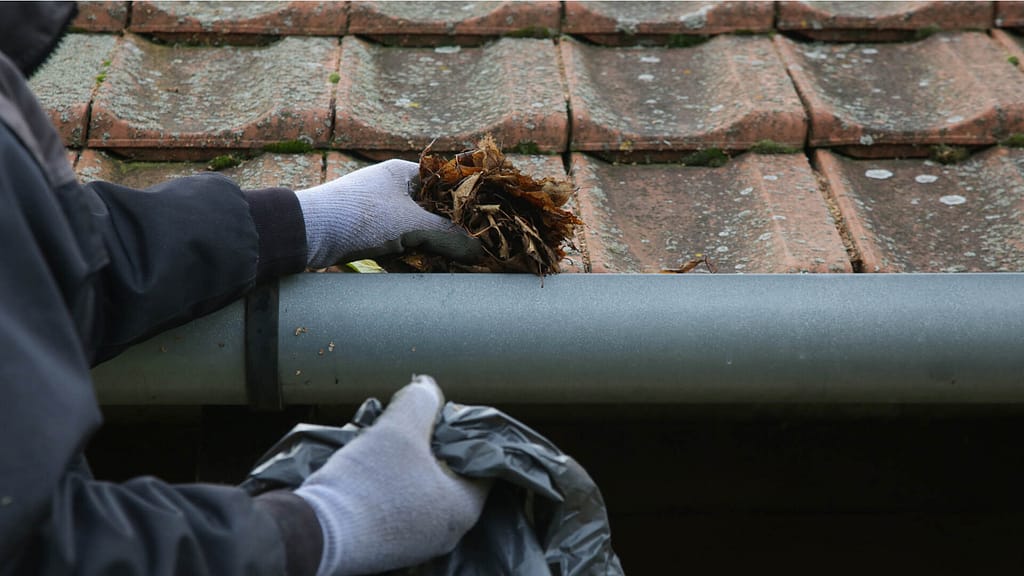
Gutters and downspouts are essential for directing water away from your home. When they’re clogged with leaves or debris, their efficiency diminishes, leading to potential ice dam formation during colder months. It’s not just about ice dams; overloaded gutters can strain and damage the gutter system and the attached roof areas.
Moreover, water backup can infiltrate home walls and ceilings, causing further issues. To prevent these problems, prioritize cleaning gutters and downspouts before winter sets in. Start by checking downspouts for blockages, then clear out any debris. After this, a quick flush with water ensures the path is clear.
Regular inspections for damage or wear are also crucial. For homes surrounded by trees, consider gutter guards to reduce debris accumulation. By maintaining clean gutters and downspouts, you’ll minimize the risk of ice dams and protect your home’s structural integrity.
Improve Attic Insulation
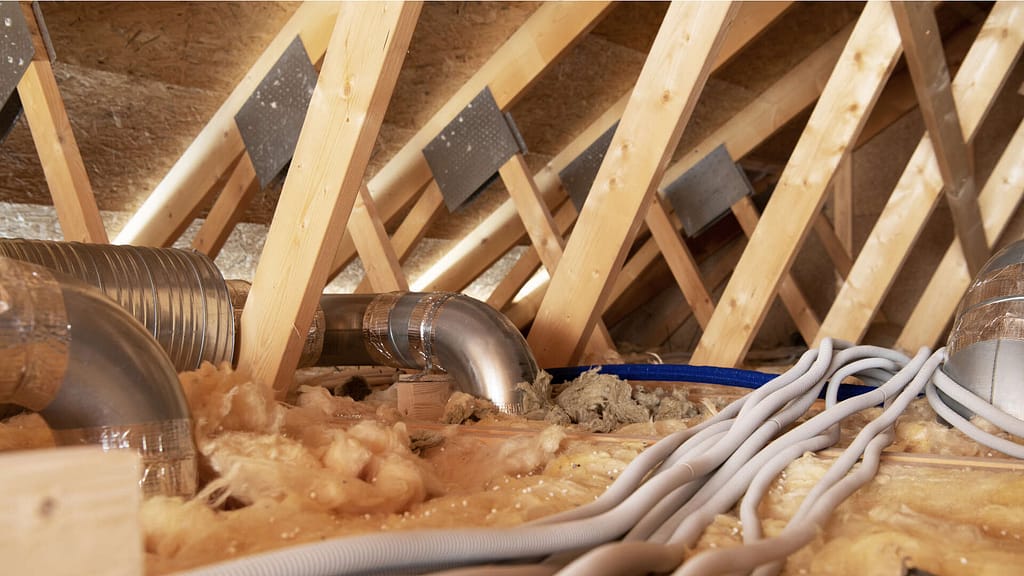
Proper attic insulation is a cornerstone in preventing ice dams. The benefits are two-fold: it keeps your home warmer in the winter and cooler in the summer, and it plays a pivotal role in preventing uneven roof temperatures, which can lead to ice dam formation.
Inadequate or uneven insulation allows heat from the living spaces below to escape into the attic. This escaping heat warms the roof from underneath, causing snow to melt, refreeze, and form ice dams. By bolstering your attic insulation, you reduce this heat transfer, maintaining a more consistent roof temperature and preventing the melt-and-freeze cycle that leads to ice dams.
It’s also worth noting that insulation effectiveness is measured in R-values, with higher R-values indicating better insulating effectiveness. It’s essential to check the recommended R-values for your specific region and ensure that your attic meets or exceeds those standards. This not only guarantees optimal thermal performance but also fortifies your home against the detrimental effects of ice dams.
Ensure Proper Attic Ventilation
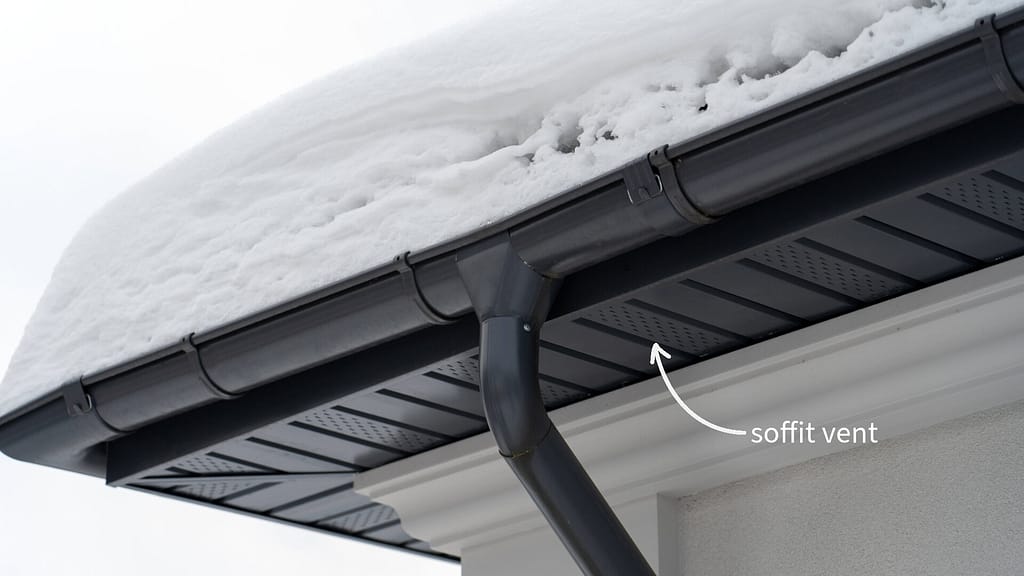
Attic ventilation is a critical component in maintaining the health and longevity of your roof, and more importantly, in the context of this article, in preventing ice dam formation. Proper attic ventilation ensures a continuous flow of outside air through the attic, helping to protect the efficiency of your insulation and reduce the risk of ice dams.
When attic ventilation is compromised, it can lead to a buildup of excess heat and moisture. This excess heat can cause the snow on your roof to melt unevenly. As this melted snow then refreezes, it forms the ice dams we’re keen to avoid. By ensuring a steady flow of cold air into the attic, the entire roof remains at a consistent temperature, reducing the chances of this problematic melt-and-refreeze cycle.
There are various types of vents available for attics, such as soffit vents, ridge vents, and gable vents. The key is to ensure a balanced system where intake (usually through soffit vents) and exhaust (typically via ridge or gable vents) are equally effective. Proper placement and sizing of these vents are essential. It’s often recommended to consult with a roofing professional to design an effective ventilation system for your specific home.
While attic insulation is about keeping the warmth in, attic ventilation is about letting the right amount of cold air in. Together, they create a balanced environment that mitigates the risk of ice dams and preserves the integrity of your roof. If you’re residing in a heavy snow-prone area such as New Hampshire, ensuring proper attic insulation and ventilation is not just beneficial—it’s essential. It can strengthen your roof’s resilience against harsh weather conditions and possibly minimize or even eliminate the hefty cost of a future roof replacement in New Hampshire.
Proactive Measures During Winter Season
Winter, with its heavy snowfalls, presents a challenge for homeowners keen on preventing ice dams. However, by taking proactive measures during these snowy months, you can significantly reduce the risk of ice dam formation and the associated damage. Here are some strategies to consider:
Roof Raking
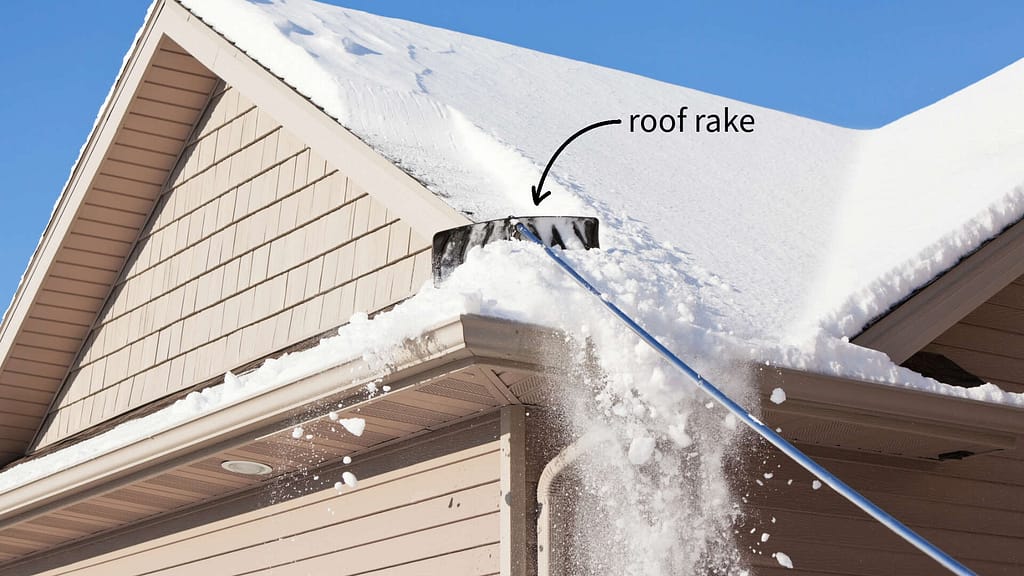
Roof raking is a preventative measure taken during the winter to reduce the risk of ice dam formation. By removing snow from the roof’s edge, homeowners can prevent melted snow from refreezing and forming ice dams. Note: It’s crucial to prioritize safety by using a specialized long-handled rake from the ground, avoiding the dangers of climbing onto snowy roofs. Snow seems harmless but can be very dangerous. Make sure to follow all safety instructions included with your snow rake.
The goal is to clear a few feet of snow from the roof’s edge, ensuring that melting snow has an unobstructed path off the roof. Investing in a quality roof rake and practicing this method after significant snowfalls can play a pivotal role in maintaining the roof’s health and preventing potential damage.
Calcium Chloride Ice Melt
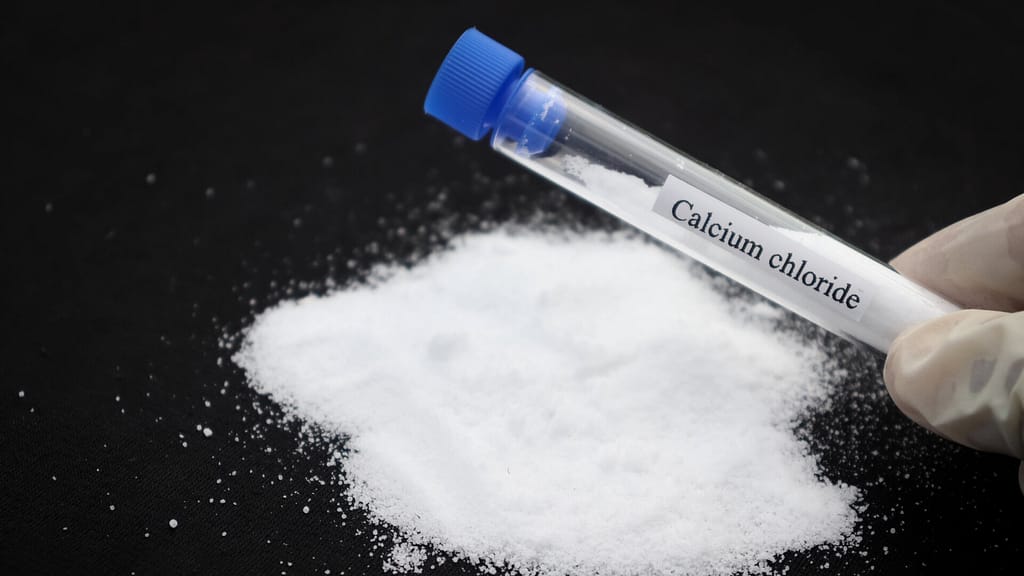
Calcium chloride is a popular solution to combat stubborn ice formations, including ice dams. Recognized for its powerful ice-melting capabilities, calcium chloride works by lowering the freezing point of water, and rapidly turning ice back into its liquid state, even at very low temperatures.
For homeowners faced with ice dams, applying calcium chloride in the form of a pellet or flake can help dissolve these problematic ice build-ups. To use, it’s commonly recommended to fill a nylon stocking or mesh bag with calcium chloride pellets and then place it vertically across the ice dam. As the compound melts the ice, it creates channels that allow trapped water to drain away from the roof, preventing potential damage.
Note: It’s essential, however, to exercise caution when using calcium chloride. Direct contact with plants or the lawn can cause damage, so ensure runoff pathways are clear. Additionally, always handle with gloves to prevent skin irritation.
Professional Solutions
In the battle against ice dams, while DIY methods provide initial relief, there are moments when the expertise of a professional becomes invaluable. Beyond the realm of do-it-yourself, there lies a range of advanced solutions that not only address the symptoms of ice dams but tackle their root causes.
Heated Roof Cables
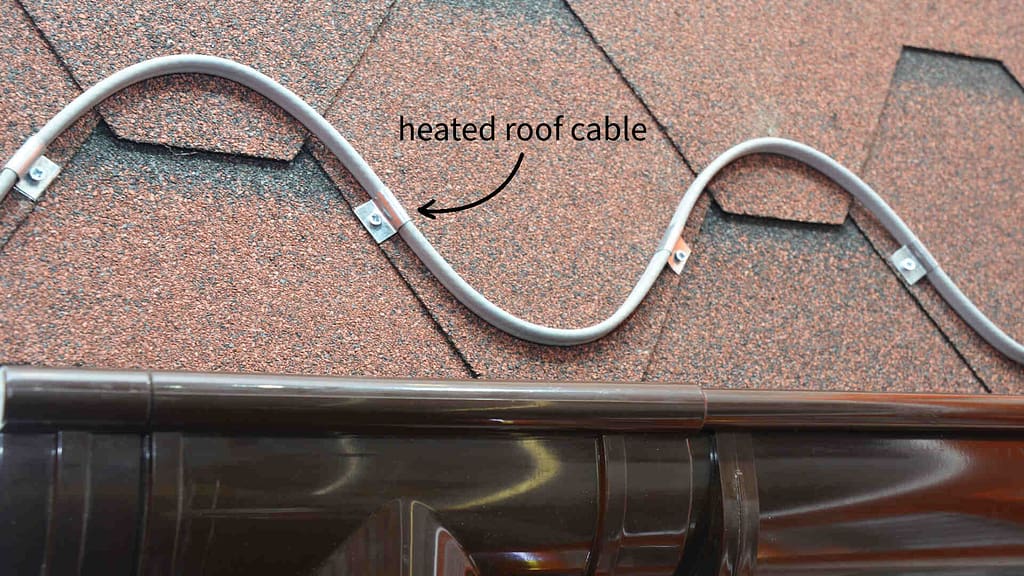
Heated roof cables, often referred to as heat tape or de-icing cables, are a strategic solution to combat ice dams. These cables are placed along the roof edges, gutters, and downspouts, producing just enough heat to melt ice and ensure a clear pathway for water runoff.
Professional installation is typically recommended for safety and effectiveness. Modern designs prioritize energy efficiency, with some cables featuring thermostatic controls to activate only when needed. Although they require minimal maintenance, periodic inspections are crucial to ensure their optimal performance. For maximum protection against ice dams, use heated cables with other preventative measures.
Consult with an Energy Auditor or Roofing Specialist

Engaging with an energy auditor or roofing specialist can be a pivotal step in both understanding and addressing ice dam concerns. These professionals assess your home’s energy efficiency, identifying heat loss areas causing ice dams.
An energy auditor, specifically, can suggest improvements to insulation, ventilation, and overall energy consumption, which not only reduce the risk of ice dams but also lead to potential energy savings. A roofing specialist, on the other hand, offers insights specifically tailored to your roof’s condition and design. They identify vulnerabilities, suggest appropriate materials, and provide tailored solutions for your home.
Conclusion
Navigating the icy challenges that winter presents to homeowners is a test of both knowledge and preparedness. If overlooked, ice dams can lead to major structural and aesthetic issues. Using this guide, homeowners can better combat the risks of these icy invaders. A holistic approach, combining DIY and professional methods, best defends against ice dams. Protecting your home from ice dams involves addressing underlying issues, ensuring warmth and safety in winter.
Fact checked by Jacob Petrosky – 10/16/23
